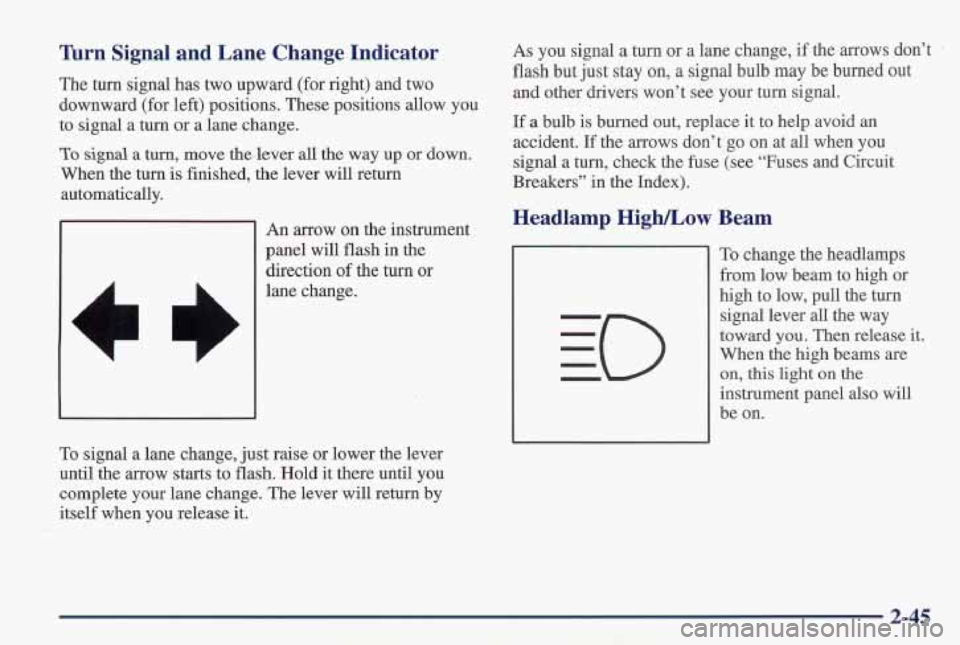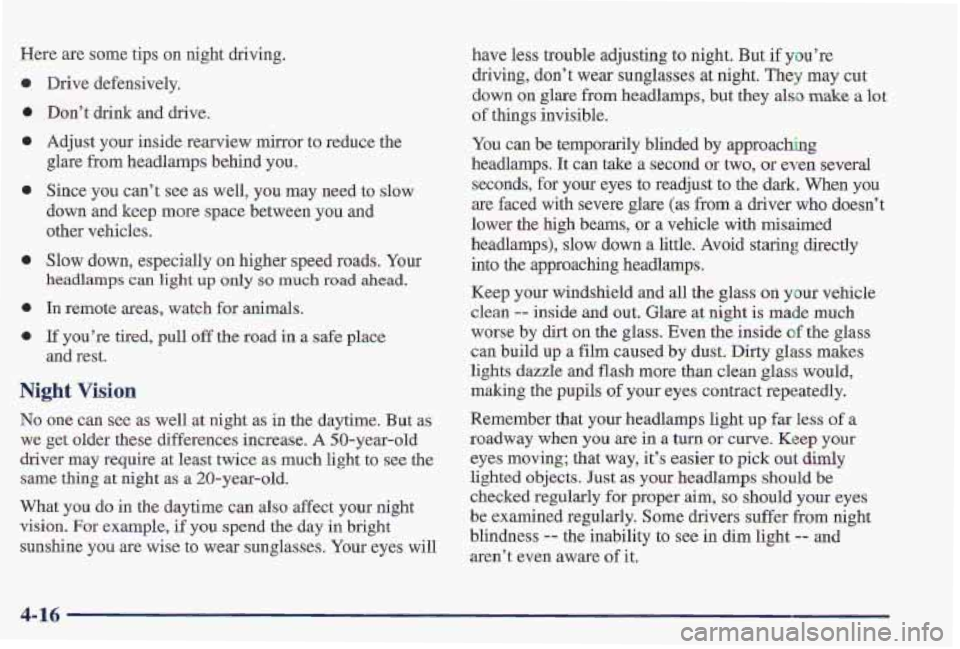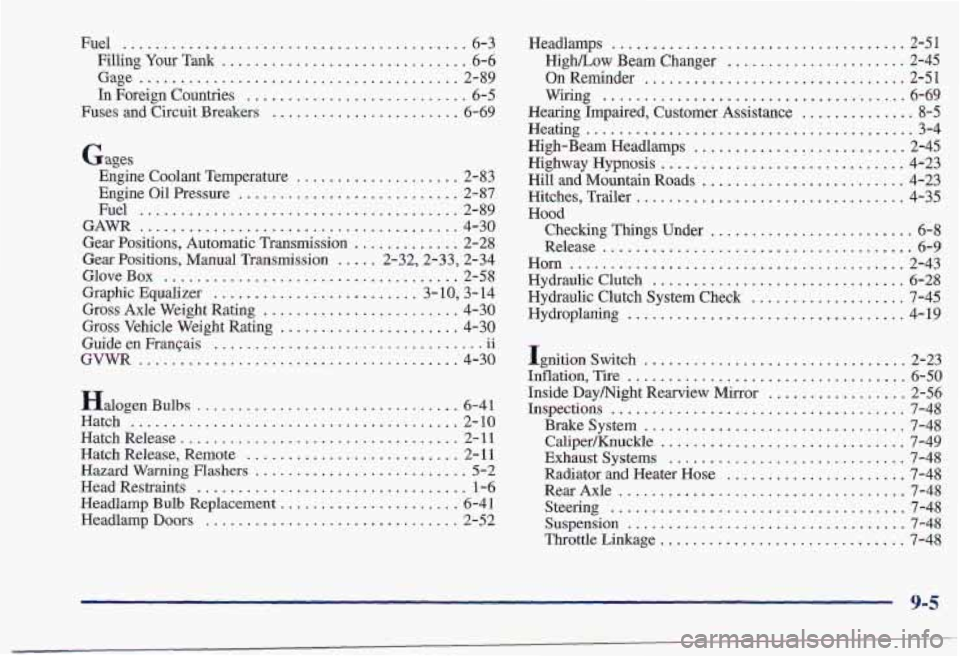high beam PONTIAC FIREBIRD 1997 Owners Manual
[x] Cancel search | Manufacturer: PONTIAC, Model Year: 1997, Model line: FIREBIRD, Model: PONTIAC FIREBIRD 1997Pages: 410, PDF Size: 19.2 MB
Page 93 of 410

Tilt Steering Wheel Thrn SignaVMultifunction Lever
A tilt steering wheel allows you to adjust the steering
wheel before
you drive.
You can also raise it to the highest level to give your
legs more room when
you exit and enter the vehicle.
To tilt the wheel, hold the steering wheel and pull the
lever. Move the steering wheel to
a comfortable level,
then release the lever to lock the wheel in place.
The lever on the left side of the steering column
includes your:
0 Turn Signal and Lane Chaaage Indicator
0 Headlamp HighLow Beam Changer and
Passing Signal
Windshield Wipers
Windshield Washer
Cruise Control (Option)
2-44
Page 94 of 410

Turn Signal and Lane Change Indicator
The turn signal has two upward (for right) and two
downward (for left) positions. These positions allow you
to signal a turn or a lane change.
To signal a turn, move the,lever all the way up or down.
When the turn
is finished, the lever will return
automatically.
An arrow
on the instrument
panel will flash in the
direction of the turn
or
lane change.
To signal a lane change, just raise or lower the lever
until the arrow starts to flash. Hold it there until you
complete your lane change. The lever will return by
itself when you release
it.
As you signal a turn or a lane change, if the arrows don’t
flash but just stay on,
a signal bulb may be burned out
and other drivers won’t see your turn signal.
If a bulb is burned out, replace it to help avoid an
accident. If the arrows don’t go on at all when you
signal a turn, check the
fuse (see “Fuses and Circuit
Breakers” in the Index).
Headlamp High/Low Beam
To change the headlamps
from low beam to high or
high to low, pull the turn
signal lever all the way
toward
you. Then release it.
When the high beams are
on, this light
on the
instrument panel also will
be on.
2-45
Page 102 of 410

Daytime Running Lamps
Daytime Running Lamps (DRL) can make it easier for
others to see the front of your vehicle during the day.
DRL can be helpful in many different driving
conditions, but they can be especially helpful in the
short periods after dawn and before sunset.
In Canada, a light sensor on top of the instrument
panel automatically turns the headlamps on,
so be
sure it isn’t covered.
The DRL system will make your front turn signal lamps
come on when:
The ignition is on,
The headlamp switch is OFF and
0 The parking brake is released.
When
the DRL are on, only your front turn signal lamps
will be on. The taillamps, sidemarker and other lamps
won’t be on.
Your instrument panel won’t be lit up either.
For Canadian vehicles when it’s dark enough outside,
your front turn signal lamps will go out and your
headlamps will come on. The other lamps that come on
with your headlamps will also come on. When it’s bright
enough outside, the regular lamps will go off, and your
front turn signal lamps will come on. On a non-Canadian vehicle the headlamps have
to be
turned on manually when you need them. When the
headlamps are turned
on, the front turn signal lamps
will go out. When you use your turn signals, the front
turn signal lamp and the taillamp on the desired side
will flash.
As with any vehicle, you should turn OM the regular
headlamp system when you need it.
Fog Lamps (If Equipped)
Use your fog lamps for better vision in foggy or misty
conditions. Your parking lamps must be on or your fog
lamps won’t work.
0s To turn the fog lamps on, push the right side of the
fog lamp switch. Push the left side of the switch to turn
the fog lamps
off. A light on the switch will come on
when the fog lamps are on.
Fog lamps will go off whenever your high beams come
on. When the high beams
go off, the fog lamps will
come on again.
If your vehicle is equipped with the Vehicle and Content
Theft-Deterrent System and your fog lamp switch is on,
the fog lamps may flash to indicate operation of the
Vehicle and Content Theft-Deterrent System. See “Vehicle
and Content Theft-Deterrent System” in the Index.
2-53
Page 181 of 410

Here are some tips on night driving.
a
e
0
m
e
e
e
Drive defensively.
Don’t drink and drive.
Adjust your inside rearview mirror to reduce the
glare from headlamps behind you.
Since you can’t
see as well, you may need to slow
down and keep more space between you and
other vehicles.
Slow down, especially
on higher speed roads. Your
headlamps can light up only so much road ahead.
In remote areas, watch for animals.
If you’re tired, pull off the road in a safe place
and rest.
Night Vision
No one can see as well at night as in the daytime. But as
we get older these differences increase.
A 50-year-old
driver may require at least twice as much light to see
the
same thing at night as a 20-year-old.
What you do in the daytime can
also affect your night
vision.
For example, if you spend the day in bright
sunshine
you are wise to wear sunglasses. Your eyes will have
less trouble adjusting to night. But if you’re
driving, don’t wear sunglasses at night. They may cut
down on glare
from headlamps, but they also make a lot
of things invisible.
You can be temporarily blinded by approaching
headlamps.
It can take a second or two, or even several
seconds, for your eyes to readjust to
the dark. When you
are faced with severe glare (as from a driver who doesn’t
lower the high beams, or a vehicle with misaimed
keadlamps), slow down
a little. Avoid staring directly
into the approaching headlamps.
Keep your windshield and all the glass on your vehicle
clean
-- inside and out. Glare at night is made much
worse
by dirt on the glass. Even the inside of the glass
can build up
a film caused by dust. Dirty glass makes
lights dazzle and
flash more than clean glass would,
making
the pupils of your eyes contract repeatedly.
Remember that your headlamps light
up far less of a
roadway when you are in a turn
or curve. Keep your
eyes moving; that way, it’s easier
to pick out dimly
lighted objects. Just
as your headlamps should be
checked regularly for proper aim, so should your eyes
be examined regularly. Some drivers suffer from night
blindness
-- the inability to see in dim light -- and
aren’t even aware of it.
4-16
Page 294 of 410

It is recommended that the upper limit not exceed plus
0.4 degrees from the center of the bubble. Other drivers
may flash their high beams at you if your adjustment
is
much above plus 0.4 degrees.
Tires
Your new Pontiac comes with high-quality tires made
by a leading tire manufacturer.
If you ever have
questions about your tire warranty and where to obtain
service, see your Pontiac Warranty booklet for details.
Pa - - ly maintained and imp1 ,derly L,Ld tires
are dangerous.
Overloading your tires can cause overheating
as
a result of too much friction. You could have
an air-out and
a serious accident. See “Loading
Your Vehicle” in the Index.
CAUTION: (Continued) CAUTION:
(Continued,
0 Underinflated tires pose the same darlger as
overloaded tires. The resulting accident
could cause serious injury. Check all tires
frequently to maintain the recommended
pressure. Tire pressure should be checked
when your tires are cold.
cut, punctured or broken by a sudden
impact
-9 such as when you hit a pothole.
Keep tires at the recommended pressure.
Worn, old tires can cause accidents. If your
tread is badly worn, or if your tires have
been damaged, replace them.
See “Inflation
-- Tire Pressure” in this section
for inflation pressure adjustment for higher
speed driving.
Overinflated tires are more likely to be
6-49
Page 394 of 410

Fuel ................. ........... 6-3
Filling Your Tank .............................. 6-6
Gage ....................................... 2-89
In Foreign Countries ........................... 6-5
Fuses and Circuit Breakers ....................... 6-69 Headlamps
................................ 2-5 1
HighLow Beam Changer
...................... 2-45
On Reminder ................................ 2-51
Wiring
..................................... 6-69
Hearing Impaired. Customer Assistance .............. 8-5
High-Beam Headlamps 2-45
Highway Hypnosis
.............................. 4-23
Heating
........................................ 3-4
Engine
(khnt Temperature .................... 2-83 Hill and Mountain Roads ......................... 4-23
Engine oil Pra~re
........................... 2-87 Hitches. Trailer ................................. 4-35
..........................
Gages
Fuel
....................................... 2-89 Hood
GAWR
....................................... 4-30 Checking Things Under ......................... 6-8
Gear Positions. Automatic Transmission ............. 2-28 ......................................
Gear Positions. Manual Transmission 2-32.2-33. 2-34 Horn 2-43
Release 6-9
Graphic Equalizer
......................... 3-10? 3-14 Hydraulic Clutch System Check ................... 7-45
Gross Vehicle Weight Rating ...................... 4-30
Guide en Frangais
. . ' * all
..... .........................................
Glove Box .................................... 2-58 Hydraulic Clutch ............................... 6-28
Gross Axle Weight Rating
........................ 4-30 Hydroplaning .................................. 4-19
.. ....................
GVWR ................................ .. 4-30 Ignition Switch ................................ 2-23
Inflation. Tire
.................................. 6-50
Inside Daymight Rearview Mirror
................. 2-56
Halogen Bulbs .......... ............ 6-41 Inspections .................................... 7-48
Hatch
........................................ 2-10 Brakesystem ................................ 7-48
Hatch Release .................................. 2- 11 Caliper/Knuckle .............................. 7-49
Hatch Release. Remote .......................... 2- 11 Exhaust Systems ............................. 7-48
Hazard Warning Flashers .......................... 5-2 Radiator and Heater Hose ...................... 7-48
Head Restraints
................................. 1-6 RearAxle 7-48
Headlamp
Bulb Replacement ...................... 6-4 1 Steering .................................... 7-48
Headlamp
Doors ............................... 2-52 Suspension .................................. 7-48
Throttle Linkage .............................. 7-48
...................................
9-5